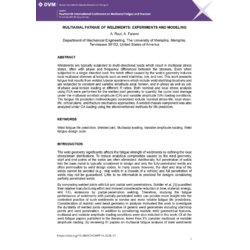- Online only



Multiaxial states result in weldments subjected to multi-channel loads including axial load, bending, and torsion in different combinations, and often with phase and frequency differences between the channels resulting in nonproportionality of the stresses. Even when subjected to a single direction load, the notch effect caused by the weld’s geometry induces local multiaxial stresses at hotspots such as weld start/stop, toe, and root). Over the years, efforts have been made to provide insight into the multiaxial fatigue of steel weldments through experiments and analyses with an emphasis on life estimation. In this work, fatigue lives were predicted based on an original dataset of multiaxial fatigue experiments of welded tubular specimens, including constant amplitude (CA) and…

Datenschutzbedingungen (bearbeiten im Modul "Kundenvorteile")

Lieferbedingungen (bearbeiten im Modul "Kundenvorteile")

Rücksendebedingungen (bearbeiten im Modul "Kundenvorteile")
Multiaxial states result in weldments subjected to multi-channel loads including axial load, bending, and torsion in different combinations, and often with phase and frequency differences between the channels resulting in nonproportionality of the stresses. Even when subjected to a single direction load, the notch effect caused by the weld’s geometry induces local multiaxial stresses at hotspots such as weld start/stop, toe, and root). Over the years, efforts have been made to provide insight into the multiaxial fatigue of steel weldments through experiments and analyses with an emphasis on life estimation. In this work, fatigue lives were predicted based on an original dataset of multiaxial fatigue experiments of welded tubular specimens, including constant amplitude (CA) and variable amplitude (VA) loading conditions. Life prediction analyses included a comprehensive approach including nominal stress-life, local strain-life, critical plane, and fracture mechanics. The developed framework for crack initiation-based analysis was also employed for life prediction of a welded chassis component under CA loading condition which resulted in reasonable accuracy. Application of popular weld design codes (IIW, EC3, BS-7608) for multiaxial fatigue life prediction was also investigated and two methods were proposed for life estimation under variable amplitude loading conditions.
For CA analysis, all the aforementioned approaches resulted in similar accuracy in life predictions, mostly within a factor of 5 of experimental lives. Under VA loading conditions, however, FS critical plane approach showed more robustness and better accuracy, compared to the equivalent stress/strain-based approaches. By geometrical simplification of the welded tubular specimen, closed-form stress intensity factor expressions of a cracked plate were also used for fatigue life prediction based on linear elastic fracture mechanics. The predictions for small crack growth rates and fatigue lives were reasonably accurate, as compared to the observed experimental observations, as shown in Figure 1(a) for CA loading and in Figure 1(b) for VA loading. With regards to weld design codes, fatigue life predictions based on IIW guidelines were more accurate than EC3 and BS-7608 and using uniaxial fatigue classes for equivalent stress of pure shear cases was found to improve the predictions, compared to shear design curves. The proposed methods based on the standards for fatigue life prediction under multiaxial VA loading condition showed good accuracy and applicability.